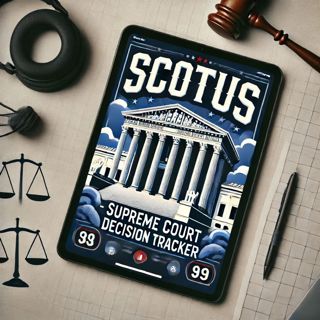
Supreme Court Rulings Reshape American Landscape: Key Cases Involving Trump and North Carolina Environmental Concerns
The Supreme Court of the United States often finds itself at the center of significant and contentious legal battles, shaping significant aspects of American life with its decisions. Two notable cases in recent times involve former President Donald Trump and environmental concerns in North Carolina.Donald Trump's legal team argues that his communications with then-Vice President Mike Pence regarding the 2020 election should be excluded from his impending trial in Washington, D.C. This legal maneuver reflects Trump's broader strategy to limit the scope of evidence regarding his actions and communications around the tumultuous period following the 2020 election results. The lawyers' efforts to keep Pence's communications out of the courtroom underscore the pivotal role that these discussions could play in the ongoing legal evaluations of Trump’s attempts to challenge the election outcome.Meanwhile, in North Carolina, the state Supreme Court is deliberating a significant environmental case, Gardner v. Richmond County, that could determine the future of a proposed CSX industrial plant. The case raises crucial questions about sustainable development and environmental protection, particularly the potential impacts on the water source near Richmond County. At stake is how industrial growth should be balanced with environmental and community health, particularly in areas where resources like clean water are essential.The outcomes of these two cases could have profound implications. In Trump's case, the heart of the legal battle revolves around issues of presidential conduct and electoral integrity. The decision about whether Pence’s communications will be admissible could significantly influence the narrative and outcome of the trial. In North Carolina, the decision by the Supreme Court could either pave the way for the CSX plant, promoting economic development, or prioritize environmental protection and community well-being, setting a precedent for future industrial projects near sensitive ecosystems.These cases exemplify the types of disputes the Supreme Court is called to adjudicate, reflecting their wide-reaching implications not just legally, but also socially and environmentally. The decisions will likely resonate beyond the courtroom, influencing future legal standards and governmental policies.This content was created in partnership and with the help of Artificial Intelligence AI
26 Syys 20242min

Supreme Court Rulings Reshape Legal Landscape Across States
In a series of consequential rulings, the Supreme Court has significantly shaped legal outcomes in various states. One such decision involved the Missouri Supreme Court, which decided to proceed with the execution of Marcellus Williams. Despite arguments from Williams’ legal team asserting his innocence, the Court upheld the judgment, suggesting that the evidence or argumentation provided was insufficient to overturn the initial conviction.Another notable development occurred in Wyoming, where the state Supreme Court opened the door for individuals to sue law enforcement officers. This controversial decision has stirred debate among legislators and law enforcement agencies, with some seeing it as a move into "extremely dangerous territory" for policing practices. The broader implications of this verdict have prompted discussions about potential legislative amendments to curb such lawsuits, reflecting a significant tension between judicial rulings and legislative responses.Meanwhile, the U.S. Supreme Court's 2023 decision on affirmative action has dramatically impacted admissions practices across the country, specifically at institutions like the University of North Carolina (UNC). The Court's ruling, which stemmed from the case Students for Fair Admissions v. President and Fellows of Harvard College, effectively banned the use of race-conscious admissions practices. This landmark decision has forced numerous educational institutions to reevaluate and potentially redesign their admissions criteria to comply with the new legal landscape, emphasizing a shift towards race-neutral processes.These high-profile cases underscore the powerful role of the judicial system in not only interpreting law but also in influencing societal norms and institutional practices across various sectors, including education and law enforcement. Each decision not only reflects the prevailing legal standards but also sets new precedents that can have long-lasting impacts on both policy and community relations.This content was created in partnership and with the help of Artificial Intelligence AI
24 Syys 20242min

Supreme Court Rulings Reshape Environmental, Telecommunications, and Child Protection Policies Worldwide
The Supreme Court of the United States (SCOTUS) has been at the center of several crucial legal battles recently, highlighting its critical role in interpreting and enforcing federal laws across diverse domains. Among such significant cases, notable developments include an intense legal tussle involving the city of San Francisco and the Environmental Protection Agency (EPA) over the provisions of the Clean Water Act, a clear indication of escalating tensions in environmental regulatory practices.In an unrelated yet equally significant case, the Supreme Court delivered a unanimous verdict in a lawsuit related to a telecommunications deal involving the Guam Department of Education (GDOE). The justices overturned a Superior Court judge’s decision, which had previously blocked GDOE from contracting with GTA, the winning bidder. This ruling underscores the Supreme Court's influential role in adjudicating cases that have profound implications for both governmental operations and corporate sectors.Simultaneously, the Supreme Court of India has made headlines for its rulings concerning the protection of children against sexual exploitation. In a landmark judgment, the court ruled that the storage of child pornography is an offense under the Protection of Children from Sexual Offences (POCSO) Act. Additionally, the court has called on the Parliament to amend the term ‘child pornography’ to ‘child sexual exploitative and abusive material’, indicating a shift towards more accurate and impactful legal terminology aimed at better safeguarding children against abuse and exploitation.These cases highlight the dynamic and pivotal role of judicial systems in shaping legal standards and societal norms. From environmental regulations in the United States to child protection laws in India, the decisions made by supreme courts have a lasting impact on both policy and public perception, demonstrating their enduring influence on justice and governance globally.This content was created in partnership and with the help of Artificial Intelligence AI
23 Syys 20242min

"Judicial Influence Worldwide: Supreme Court Rulings Reshape Politics, Economics, and Culture Globally"
The Supreme Court's influence extends globally across various domains, including politics, commerce, and art. Recently, its decisions in various countries have shown the impacts and controversies associated with its rulings.In the U.S., Vice President Kamala Harris visited Georgia to emphasize the tragic consequence of the state's abortion ban, following a report of a woman's death linked directly to the restrictive law. This situation underscores the ongoing national debate about reproductive rights and how Supreme Court decisions can directly affect individual lives and health policies.Meanwhile, in India, the economic sector is feeling the effects of the Supreme Court's decisions as well. The Goa Chamber of Commerce and Industries has called for an urgent review of a Supreme Court judgment regarding mineral taxation. The ruling has significant implications for the local economy, particularly for industries involved in mineral extraction and processing. These sectors argue that the taxation levels mandated by the court could hinder economic growth and sustainability in the region, reflecting the broader dialogue about the balance between regulatory measures and economic development.In the realm of art and culture in Spain, the Supreme Court's decision is awaited with bated breath as it deliberates on the fate of a potentially valuable painting, hesitantly attributed to Velázquez, titled "Portrait of a Cleric." The decision on whether to allow the export of the painting could have significant implications for the art market in Spain. If the court permits its sale abroad, it could lead to an outflow of cultural assets and potentially increase the valuation of Spanish art worldwide. Conversely, retaining the artwork within Spain could bolster the national cultural heritage and reinforce a sense of national pride.These instances highlight how Supreme Court decisions are pivotal in shaping not just legal but also economic, cultural, and societal landscapes. Each ruling not only resolves specific legal questions but also sets precedents that affect broader issues, showcasing the profound and wide-reaching authority of such judicial bodies.This content was created in partnership and with the help of Artificial Intelligence AI
22 Syys 20242min

"Brazil Restores Twitter Access Amid Court Battles, Spotlighting Digital Sovereignty Debates"
In a move that demonstrates the dynamic interplay between technology and regulatory frameworks, some Brazilian users of X, formerly known as Twitter, regained access amid a nationwide ban imposed by the country's Supreme Court. This development occurred after adjustments were made concerning server access, allowing the platform to circumvent the initial restrictions. Such incidents highlight ongoing global debates over digital sovereignty and the power of national governments to regulate the internet.Meanwhile, in the United States, political reverberations from the Supreme Court's decision in Dobbs v. Jackson Women's Health Organization, which overturned Roe v. Wade, continue to influence various aspects of governance and policy. Recently, Republicans have leveraged the ruling to request that the funding decisions for Claremont schools be revisited, depicting how seminal court decisions can have wide-ranging impacts beyond their immediate legal contexts.Additionally, the Michigan Supreme Court has affirmed an increase in the minimum wage to $12.48 an hour starting next year. This decision comes amid ongoing debates about wage standards and economic policy in the U.S., affecting workers across various sectors, including the hospitality industry. The adjustment in wage policy was showcased during events like the Save MI Tips rally, underscoring the connection between judicial decisions and everyday economic realities for American workers.These events underscore the influence of supreme courts in shaping the social, economic, and digital landscapes within their jurisdictions, reflecting broader themes of legal authority, public policy, and societal change.This content was created in partnership and with the help of Artificial Intelligence AI
19 Syys 20241min

"Navigating the Supreme Court's Influence on Education Policy: Diversity, Speech, and the Changing Legal Landscape"
The Supreme Court often finds itself at the heart of some of the most pivotal debates shaping American society. A recent push by Republicans, citing the controversial fall of Roe v. Wade, has emerged in the sphere of education policy, specifically targeting funding decisions tied to the Claremont School District. This strategic move is noted in an amicus brief spearheaded by prominent figures, including House Speaker Sherman Packard, suggesting that past court interventions in educational funding should be reconsidered based on the new judicial climate post-Roe.Concurrently, educational institutions are facing other significant changes following shifts in the legal landscape, particularly concerning affirmative action policies. For example, in North Carolina, institutions like UNC Charlotte and Duke University are undergoing adaptations to uphold diversity in their enrollment processes. This action follows the evolving judicial stance on affirmative action, with these universities seeing an increase in the percentage of Black and Hispanic first-year students. Such demographics shifts depict how educational bodies are actively seeking alternative pathways to foster diversity amidst changing legal interpretations and mandates.In another vein, the power of schools to regulate speech, particularly off-campus speech, has become a contentious issue reaching the Supreme Court. This is critical as it tests the boundaries of the First Amendment concerning educational settings. The ongoing dialogue around freedom of expression and the extent to which educational institutions can exert control over student speech, especially outside school grounds, is being closely monitored. Issues like these underscore the ongoing challenge of balancing student rights and institutional responsibilities in a digital era where off-campus interactions are often publicly disseminated through social media and other online platforms.These legal challenges and adaptations occurring in the Supreme Court and across educational institutions highlight the dynamic interplay between law, policy, and societal values in shaping the educational landscape and broader societal norms in the United States.This content was created in partnership and with the help of Artificial Intelligence AI
18 Syys 20242min

Ohio Supreme Court Ruling Sparks Debate over Ballot Language and Voter Clarity
In Ohio, a significant legal decision recently unfolded when Secretary of State Frank LaRose responded to a ruling by the Ohio Supreme Court concerning the suit State ex rel. Citizens Not Politicians v. Ohio Ballot Board. This pivotal decision revolved around the approval of ballot language regarding a proposed constitutional amendment, which the Ohio Ballot Board had passed by a three-to-two vote.The controversy primarily stemmed from the contested language used on the ballot. Critics, including the group Citizens Not Politicians, argued that the language could potentially mislead voters about the implications and content of the amendment, influencing their understanding and, consequently, their vote. Such disputes over ballot language are crucial as they directly affect the clarity of information provided to voters, ensuring that citizens can make informed decisions in the democratic process.Meanwhile, at the national level, there is ongoing concern within the legal community about potential shifts in judicial perspectives, especially regarding the rights of death penalty defendants in the United States. This concern is magnified by discussions and speculations around whether the conservative-leaning Supreme Court justices might reconsider established precedents that protect these defendants. Legal analysts and human rights advocates closely monitor these discussions, as any changes could significantly impact the judicial approach to capital punishment cases, influencing both legal strategies and broader human rights implications.Both these issues highlight the dynamic and continually evolving landscape of law and justice in the United States, reflecting broader debates about democracy, justice, and human rights. These legal battles not only shape state policies and national jurisprudence but also reflect deep societal values and the ongoing struggle to balance these within the frameworks of governance and law.This content was created in partnership and with the help of Artificial Intelligence AI
17 Syys 20242min

Navigating the Changing Landscape: Legal Battles Reshape Land Use, Digital Rights, and Environmental Stewardship
In recent times, discussions around land use and digital rights have taken center stage in various judicial settings, including the Supreme Court.One prominent issue concerns the push for multifamily housing in residential areas, a movement often abbreviated as "YIMBY" (Yes In My Backyard). Advocates for multifamily zoning argue that such developments are essential to address housing shortages and foster inclusive community growth. They believe that increasing the density of housing can provide broader societal benefits like reduced housing costs and decreased urban sprawl, which in turn could help in alleviating transportation woes and lowering carbon footprints. On the other side of the debate, some homeowners and residents express concerns, often termed as a "nope" stance. They worry that such changes might lead to increased traffic, strain local resources like schools and parks, and potentially disrupt community character and property values.Another legal battle brewing is over the future of TikTok in the United States. The popular video-sharing app is set to challenge a new law aimed at banning it in the country by early next year. This case is particularly significant as it tackles issues of digital privacy, national security, and free speech. The law against TikTok comes amid fears that data collected by the app could be mishandled or misused under foreign government influence, given TikTok’s Chinese parent company, ByteDance. The platform’s defense might emphasize its efforts to protect U.S. user data and point towards the potential overreach of such a ban impacting the freedom of expression and commerce.Furthermore, local disputes like the Wells Cove water rights case in Maryland also find their path to the judiciary. The case, led by Annapolis attorney Joe Donahue on behalf of residents Jessica Pachler and Karen Jennings, touches on the delicate balance of environmental stewardship and property rights. As populations grow and climates change, conflicts over natural resources like water are becoming increasingly common. Such disputes not only affect the involved parties but can also set precedents that affect water rights and environmental law broadly.Each of these cases, whether they concern zoning laws, digital privacy, or environmental rights, reflects deeper societal values and priorities. They also demonstrate the complex ways in which law interacts with everyday life and the evolving challenges that come with technological advancements and urban development.This content was created in partnership and with the help of Artificial Intelligence AI
16 Syys 20242min





















